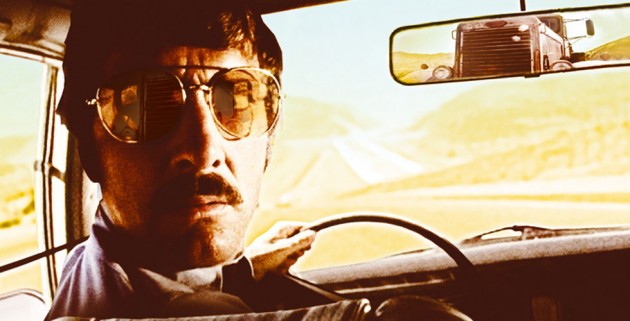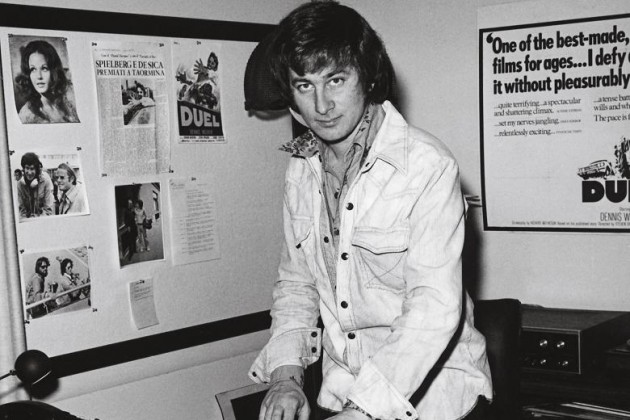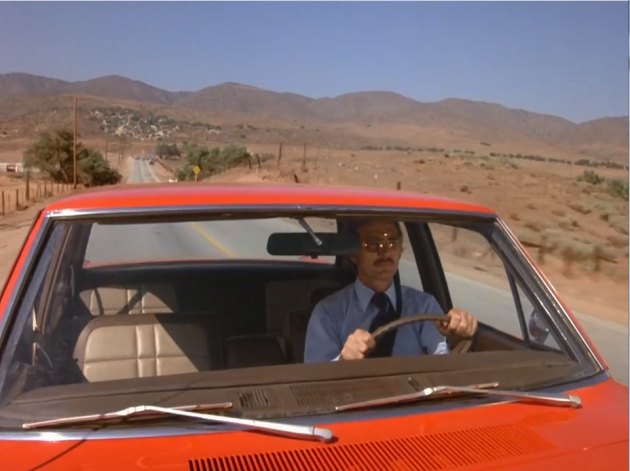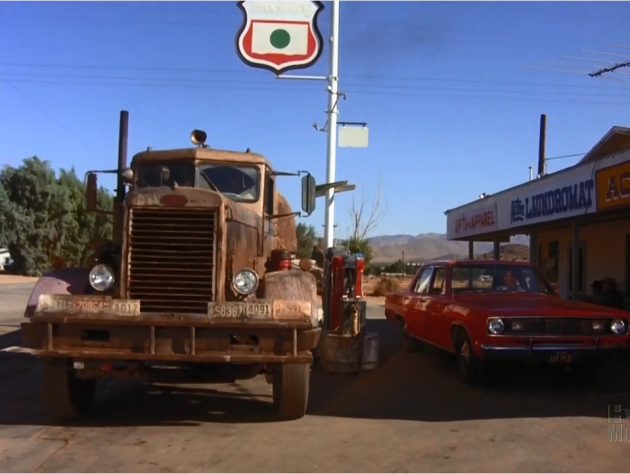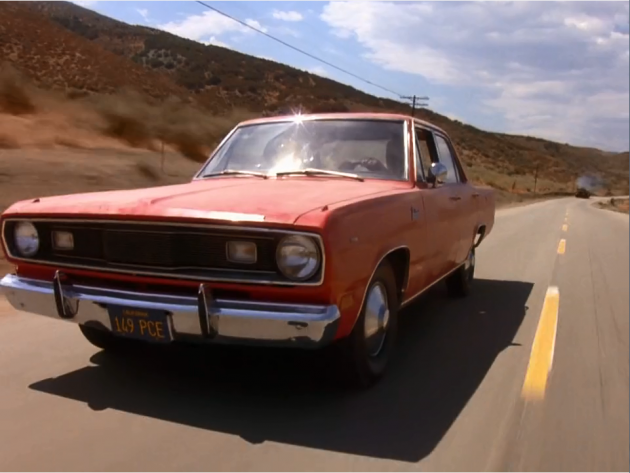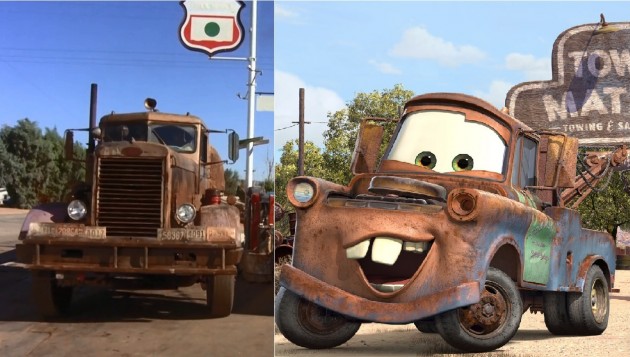Best Road Trip Movies: Duel Review
In 1971, Universal TV purchased a short story called “Duel” that had originally appeared in Playboy magazine. They hired the author adapt his own work into a teleplay, shot the project in 13 days, and aired it as an episode of ABC’s Movie of the Week series. The reception was so positive that they decided to lengthen the running time from 74 to 90 minutes and distributed it in Europe as a feature length film. Duel attracted some positive reviews overseas, but in all honesty, we probably wouldn’t be talking about it at all in the year 2014 if not for the fact that it was directed by a 25-year old film school dropout named Steven Spielberg.
Yes, that Steven Spielberg.
Duel became a young Spielberg’s first theatrically released film and his ticket out of television and into movies, where he would really hit it big four years later with the release of Jaws. The film garnered Spielberg the first serious attention he had ever gotten, as European film critics saw a commentary on class conflicts in America in the story of a mild-mannered man being relentlessly pursued by a trucker driving a huge tractor-trailer. Spielberg, on the other hand, claims he just thought he was making “the roadkill equivalent of High Noon.”
The Plot
A lot of the road trip movies that we have covered in this series merely used the genre as a vehicle (pun intended) for a buddy comedy or ensemble piece. Duel is a film, though, that’s truly focused on the act of driving, and more specifically, the act of driving alone, and the terrifying potentials that exist in that seemingly mundane task.
The short story “Duel” was written by Richard Matheson, a legendary science-fiction author best known for his novels that have been adapted into films (such as I Am Legend and The Incredible Shrinking Man) and for writing some of the best episodes of The Twilight Zone (such as “Nightmare at 20,000 Feet,” AKA “The One Where William Shatner Sees a Gremlin On the Wing of the Plane”). Matheson was inspired to write this tense little thriller after he and a friend were aggressively tailgated by a truck driver on the day of John F. Kennedy’s assassination.
In the film adaptation, Dennis Weaver stars as David Mann, a timid, non-confrontational salesman from Los Angeles who is taking a solo business trip in his red Plymouth Valiant.On a two-lane highway in the California desert, Mann comes up on a rusty old tanker truck, which he passes. The trucker seems to take offense, and begins tailgating Mann.
Then things get personal.
What follows is a fairly extreme cat-and-mouse game between Mann and the crazy trucker, whose face we never actually see (Spielberg realized that the unseen was more terrifying than the explicit, a principle which served him well when he later directed Jaws). Increasingly insane confrontations cause Mann to realize that this trucker means to kill him, and Weaver (who Spielberg chose because of his unhinged performance in Touch of Evil) does a great job portraying a man who is becoming increasingly hysterical as he is faced with an inexplicably tenacious pursuer.
(Warning: Spoiler Ahead)
Eventually, Mann actually engages in the “duel” referred to in the title when he squares off with the truck and drives straight at it. Then, at the last second, he jumps out of his Plymouth Valiant, which crashes into the truck and sends it careening off of a cliff. As the tanker truck goes into a free fall, what sounds like twisting metal is actually a Godzilla-esque dinosaur roar sound effect that Spielberg decided to insert into the film’s climax (he reused the same sound effect in the climactic scene in Jaws in which the dead shark sinks to the bottom of the ocean, despite the improbability of a fish making the same whining roar noise as a dinosaur/truck).
The Vehicles
In the film, David Mann is supposed to be driving a 1970 Plymouth Valiant sedan. In reality, three different cars were used during production. When the film was first shot for television, a 1970 model with a 318 V8 and a 1971 with a 225 Slant Six were both used during the ten days of shooting. Then, when Spielberg went back to film additional footage for the European theatrical release, a 1972 Valiant with a 225 Slant Six was used (the TV movie first aired in November of1971, three months into the 1972 model year).
Spielberg has said that he didn’t really care what kind of car was used, as long as it was a bright red color that would “pop” against the film’s desert background.
He was a bit more discerning when it came time to pick the villainous truck, though. After a long “audition,” he eventually settled upon an old 1955 Peterbilt 281 tractor unit, which he chose because the split windshields, round headlights and long needlenose hood seemed to resemble a face.
One more vehicle of note: a parked sedan that Mann hopes might be a police car, but turns out to be the service car of a pest exterminator named “Grebleips” (which is “Spielberg” spelled backwards).
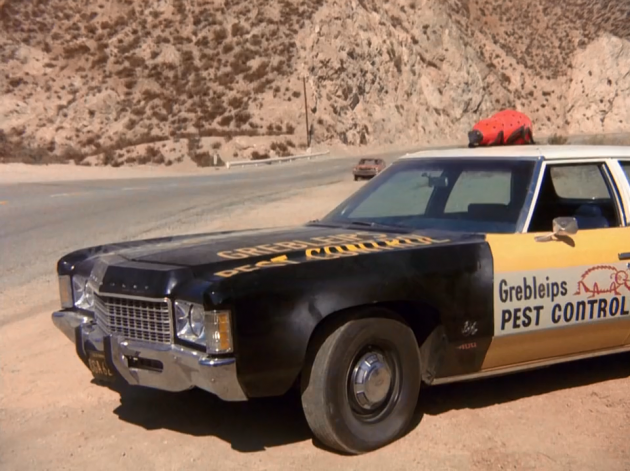
I have a feeling that Grebleips Pest Control does a lot of work in Nilbog
Duel Review
You can see the reason that Duel transcended its ABC Movie of the Week-origins to become a real feature film, as the pride that a young Spielberg took in his work is evident. Even with limited time and resources, he definitely throws everything he can into this, with creative shots and techniques that most television directors wouldn’t bother attempting. And even though Spielberg added 16 extra minutes of new scenes for the theatrical version, the film doesn’t feel padded, and retains its intensity from start to finish.
This is not the big-budget Spielberg that audiences are used to, as everything about this film feels stripped down yet effective, and it’s almost hard to believe that the same director who crafted this comparatively minimalist minor masterpiece would one day produce something as overblown as Indiana Jones and the Kingdom of the Crystal Skull.
If you’re a film buff, I would definitely recommend this movie, not just because of its importance in Spielberg’s career, but because it is a pretty great example of the cheap, quick, messy yet wonderfully visceral films that were produced by young, hungry filmmakers in the 1970’s. And even if you’re not a film buff, this is still a very good little movie.
Patrick Grieve was born in Southwestern Ohio and has lived there all of his life, with the exception of a few years spent getting a Creative Writing degree in Southeastern Ohio. He loves to take road trips, sometimes to places as distant as Northeastern or even Northwestern Ohio. Patrick also enjoys old movies, shopping at thrift stores, going to ballgames, writing about those things, and watching Law & Order reruns. He just watches the original series, though, none of the spin-offs. And also only the ones they made before Jerry Orbach died. Season five was really the peak, in his opinion. See more articles by Patrick.


